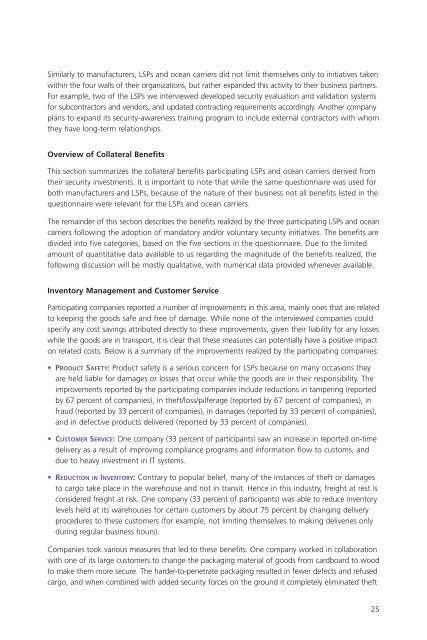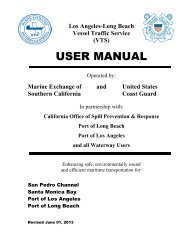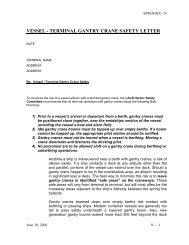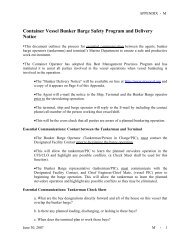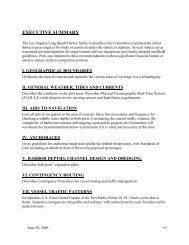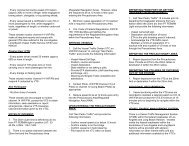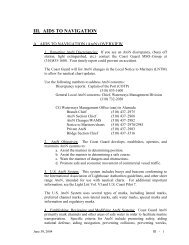Innovators in Supply Chain Security: - IBM
Innovators in Supply Chain Security: - IBM
Innovators in Supply Chain Security: - IBM
Create successful ePaper yourself
Turn your PDF publications into a flip-book with our unique Google optimized e-Paper software.
Similarly to manufacturers, LSPs and ocean carriers did not limit themselves only to <strong>in</strong>itiatives taken<br />
with<strong>in</strong> the four walls of their organizations, but rather expanded this activity to their bus<strong>in</strong>ess partners.<br />
For example, two of the LSPs we <strong>in</strong>terviewed developed security evaluation and validation systems<br />
for subcontractors and vendors, and updated contract<strong>in</strong>g requirements accord<strong>in</strong>gly. Another company<br />
plans to expand its security-awareness tra<strong>in</strong><strong>in</strong>g program to <strong>in</strong>clude external contractors with whom<br />
they have long-term relationships.<br />
Overview of Collateral Benefits<br />
This section summarizes the collateral benefits participat<strong>in</strong>g LSPs and ocean carriers derived from<br />
their security <strong>in</strong>vestments. It is important to note that while the same questionnaire was used for<br />
both manufacturers and LSPs, because of the nature of their bus<strong>in</strong>ess not all benefits listed <strong>in</strong> the<br />
questionnaire were relevant for the LSPs and ocean carriers.<br />
The rema<strong>in</strong>der of this section describes the benefits realized by the three participat<strong>in</strong>g LSPs and ocean<br />
carriers follow<strong>in</strong>g the adoption of mandatory and/or voluntary security <strong>in</strong>itiatives. The benefits are<br />
divided <strong>in</strong>to five categories, based on the five sections <strong>in</strong> the questionnaire. Due to the limited<br />
amount of quantitative data available to us regard<strong>in</strong>g the magnitude of the benefits realized, the<br />
follow<strong>in</strong>g discussion will be mostly qualitative, with numerical data provided whenever available.<br />
Inventory Management and Customer Service<br />
Participat<strong>in</strong>g companies reported a number of improvements <strong>in</strong> this area, ma<strong>in</strong>ly ones that are related<br />
to keep<strong>in</strong>g the goods safe and free of damage. While none of the <strong>in</strong>terviewed companies could<br />
specify any cost sav<strong>in</strong>gs attributed directly to these improvements, given their liability for any losses<br />
while the goods are <strong>in</strong> transport, it is clear that these measures can potentially have a positive impact<br />
on related costs. Below is a summary of the improvements realized by the participat<strong>in</strong>g companies:<br />
• PRODUCT SAFETY: Product safety is a serious concern for LSPs because on many occasions they<br />
are held liable for damages or losses that occur while the goods are <strong>in</strong> their responsibility. The<br />
improvements reported by the participat<strong>in</strong>g companies <strong>in</strong>clude reductions <strong>in</strong> tamper<strong>in</strong>g (reported<br />
by 67 percent of companies), <strong>in</strong> theft/loss/pilferage (reported by 67 percent of companies), <strong>in</strong><br />
fraud (reported by 33 percent of companies), <strong>in</strong> damages (reported by 33 percent of companies),<br />
and <strong>in</strong> defective products delivered (reported by 33 percent of companies).<br />
• CUSTOMER SERVICE: One company (33 percent of participants) saw an <strong>in</strong>crease <strong>in</strong> reported on-time<br />
delivery as a result of improv<strong>in</strong>g compliance programs and <strong>in</strong>formation flow to customs, and<br />
due to heavy <strong>in</strong>vestment <strong>in</strong> IT systems.<br />
• REDUCTION IN INVENTORY: Contrary to popular belief, many of the <strong>in</strong>stances of theft or damages<br />
to cargo take place <strong>in</strong> the warehouse and not <strong>in</strong> transit. Hence <strong>in</strong> this <strong>in</strong>dustry, freight at rest is<br />
considered freight at risk. One company (33 percent of participants) was able to reduce <strong>in</strong>ventory<br />
levels held at its warehouses for certa<strong>in</strong> customers by about 75 percent by chang<strong>in</strong>g delivery<br />
procedures to these customers (for example, not limit<strong>in</strong>g themselves to mak<strong>in</strong>g deliveries only<br />
dur<strong>in</strong>g regular bus<strong>in</strong>ess hours).<br />
Companies took various measures that led to these benefits. One company worked <strong>in</strong> collaboration<br />
with one of its large customers to change the packag<strong>in</strong>g material of goods from cardboard to wood<br />
to make them more secure. The harder-to-penetrate packag<strong>in</strong>g resulted <strong>in</strong> fewer defects and refused<br />
cargo, and when comb<strong>in</strong>ed with added security forces on the ground it completely elim<strong>in</strong>ated theft<br />
25


